Tate Modern
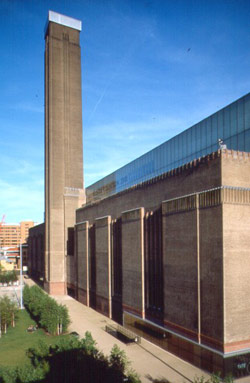
The Building
Tate Modern was created in the year 2000 to display the national collection of international modern art (defined as art since 1900). This forms part of the Tate Collection which is the national collection of British art since 1500 and international modern art. The international modern art was formerly displayed alongside the British art at what was previously the Tate Gallery and is now Tate Britain.
By about 1990 it was clear that the Tate Collection had hugely outgrown the original Tate Gallery on Millbank. It was decided to create a new gallery in London to display the international modern component of the Tate Collection. For the first time London would have a dedicated museum of modern art. At the same time, the Tate building on Millbank would neatly revert to its original intended function as the national gallery of British art.
An immediate problem was whether the modern art gallery should be a new building or a conversion of an existing building, if a suitable one could be found. As a result of extensive consultations, particularly with artists, it was decided to search for a building to convert. When the building that is now Tate Modern presented itself, it appeared something of a miracle. It was a former power station that had closed in 1982, so it was available. It was a very striking and distinguished building in its own right, by the architect Sir Giles Gilbert Scott. It offered all the space that was required. Not least, it was in an amazing location on the south bank of the River Thames opposite St Paul’s Cathedral and the City of London. Plans were almost immediately formulated to build a footbridge to link the new gallery to the City. The fact that the original Tate Gallery was also on the river made a satisfactory symmetry, and meant that the two could be linked by a riverboat service.
An international architectural competition was held attracting entries from practices all over the world. The final choice was Herzog and De Meuron, a relatively small and then little known Swiss firm. A key factor in this choice was that their proposal retained much of the essential character of the building. One of the shortlisted architects had, for example, proposed demolishing the splendid ninety-nine metre high chimney, a central feature of the building.
The power station consisted of a huge turbine hall, thirty-five metres high and 152 metres long, with, parallel to it, the boiler house. The turbine hall became a dramatic entrance area, with ramped access, as well as a display space for very large sculptural projects. The boiler house became the galleries. These are on three levels running the full length of the building. The galleries are disposed in separate but linked blocks, known as suites, on either side of the central escalators. The Tate collection of modern art is displayed on two of the gallery floors, the third is devoted to temporary exhibitions. Above the original roofline of the power station Herzog and De Meuron added a two-storey glass penthouse, known as the lightbeam. The top level of this houses a cafe-restaurant with stunning views of the river and the City, and the lower a members room with terraces on both sides of the building, the river side one offering the same stunning views as the restaurant. The chimney was capped by a coloured light feature designed by the artist Michael Craig-Martin, known as the Swiss Light. At night, the penthouse lightbeam and the Swiss Light mark the presence of Tate Modern for many miles.
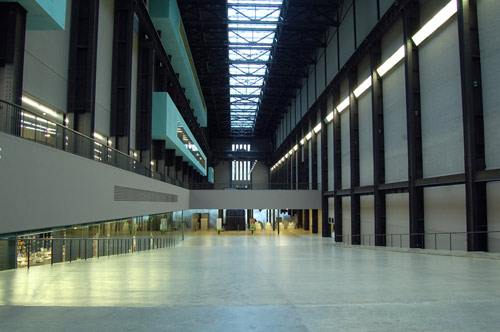
History

Built in two phases between 1947 and 1963, Bankside Power Station was designed by Sir Giles Gilbert Scott. He was also the architect of Battersea Power Station, Liverpool Anglican Cathedral, University libraries in Oxford and Cambridge, Waterloo Bridge, and the designer of the famous British red telephone box.
The western half of the structure, which included the chimney, replaced an earlier coal-fired power station, in 1952. The eastern half of the building was brought into commission in 1963. In 1981 Bankside Power Station closed due to increased oil prices, making other methods of generating electricity more efficient. Between 1981 and 1994 when the Tate Gallery acquired an option on the site, the building remained unoccupied apart from an operational London Electricity sub-station that still remains.
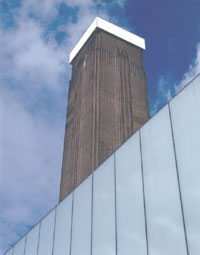
In the late 1980s it became clear to Tate that its collection had outgrown its home on Millbank. It was decided to create a new gallery to house Tate's international modern art, and a search began for a suitable site to build on, or a building that could be converted.
The redundant Bankside Power Station proved an astonishing discovery; a building of enormous size, great architectural distinction, superbly sited opposite St Paul's Cathedral and in a fascinating and historic, if neglected area, next to the rebuilt Globe Theatre. An international architectural competition was held, which over seventy architects entered, including some of the world's most distinguished. The final choice was the young Swiss practice, Jacques Herzog and Pierre de Meuron.
The Swiss Light
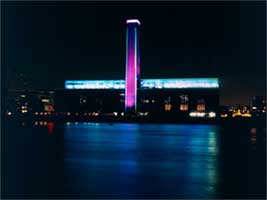
The Swiss Light is a unique enhancement to Tate Modern's chimney and acts as a symbol of the birth of Tate Modern and the reincarnation of Bankside. Michael Craig-Martin, artist and former Tate Trustee, collaborated with Herzog & de Meuron in the development of this design for the chimney. The resulting creation is a lightweight luminous roof, fabricated from translucent panels, illuminating the chimney's apex like a beacon. Artist and architect together have produced a final crowning gesture to define the major architectural and cultural achievement of Tate Modern.
The Swiss Light has been supported by the Government of Switzerland.
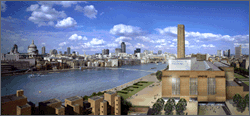
Facts and Figures
Bankside Power Station
- Situated on a 3.43 hectare (8.48 acre) site on the south side of the River Thames opposite St Paul's Cathedral
- The northern frontage of the building is over 200m (650 ft) long
- The chimney is 99m (325 ft) high, specifically built to be lower than the dome of St Paul's Cathedral at 114m (375 ft)
- The building is made up of approximately 4.2 million bricks
Tate Modern
- a total internal floor area of 34,500 sq m (371,350 sq ft)
- gallery suites for display and exhibitions of 7,827 sq m (84,250 sq ft)
- the former Turbine Hall as a 'covered street' of 3,300 sq m (35,520 sq ft)
- a special exhibition suite of 1,300 sq m
- a 240 seat auditorium
- two cafes to seat 240 and to seat 170 plus 30 in the bar area
- three shops: Level 1: 500 sq m (5,385 sq ft); Level 2: 300 sq m (3,230 sq ft); Level 4 Exhibition Shop: 150 sq m (1,615 sq ft)
- an education area of 390 sq m (4,200 sq ft)
- a Members Room of 150 sq m (1,615 sq ft)
- 1350 sq m (14,530 sq ft) of offices
- a support services/art handling area of 1,500 sq m (16,145 sq ft)
- 9 passenger lifts of which 4 are for public use (capacity of each 16 people)
- 6 escalators
Bankside
Tate Modern is situated on Bankside, an area on the south bank of the River Thames, opposite St Paul's Cathedral, 10 minutes walk from London Bridge. Bankside lies within Southwark, originally an ancient settlement which sprang up around the south end of the first London Bridge, built by the Romans shortly after their arrival in Britain in AD43.
Medieval palaces once lined the banks of this stretch of the River Thames, the rich and famous choosing it as the place to display their accumulated wealth. Bankside also became the residence for the Bishop of Winchester. Later, and over centuries, the locality drew to itself less orthodox activities. By the end of the sixteenth century Southwark had become London's chief pleasure ground, noted for gambling, bearbaiting, brothels, and above all its theatres: Shakespeare's Globe opened its doors on Bankside in 1598.
Henry VIII closed the brothels down (though they were open again by the seventeenth century) and many of the prelates' houses fell during the Reformation. The theatres were closed by the Puritans who won the English Civil War and much of the remaining palatial opulence was destroyed.
From the mid eighteenth century Bankside became increasingly active in trade, commerce and industry. By the later nineteenth century there was a gas works, an iron foundry, glass making, a coconut fibre works, a boiler works, a vinegar distillery, breweries; wharves lined the river; and 90,000 people were crammed into the Bankside ward alone. From being the location of spacious palaces of the powerful and pretentious, the area was now one of poverty, tightly packed with alleyways, factories and slums.
From the early twentieth century urban deindustrialisation brought decline, including heavy bombing in the Second World War. After the war, the new Bankside Power Station was constructed. Standing directly opposite St Paul's it was conceived by Sir Giles Gilbert Scott as a new kind of cathedral, a cathedral of pure energy. Inevitably technological change meant that the power station and much of the surrounding area gradually slipped into obsolescence. Bankside soon became just another hidden area cut off from the London mainstream.
In the late 1980s Southwark Council began to work realising Bankside's true potential. It drew up a regeneration strategy aimed at improving the accessibility of the area and its immediate environment as well as pulling investment into the area. The redevelopment of the redundant Bankside Power Station was seen as key to the regeneration of the area.
The conversion of Bankside Power Station into Tate Modern will play an important role in the redevelopment of the area south of the River Thames, so that Bankside, one of the capital's oldest districts, will once again become a vibrant area and provide a new cultural focus for London.